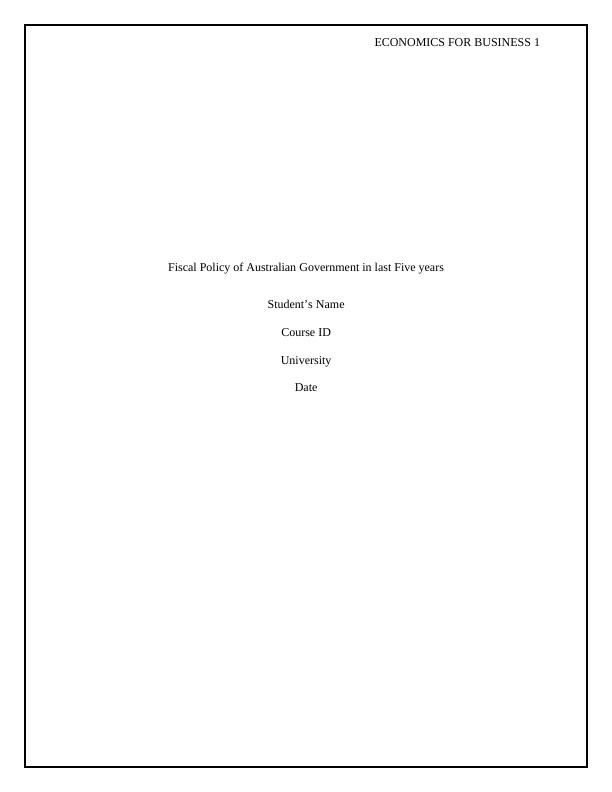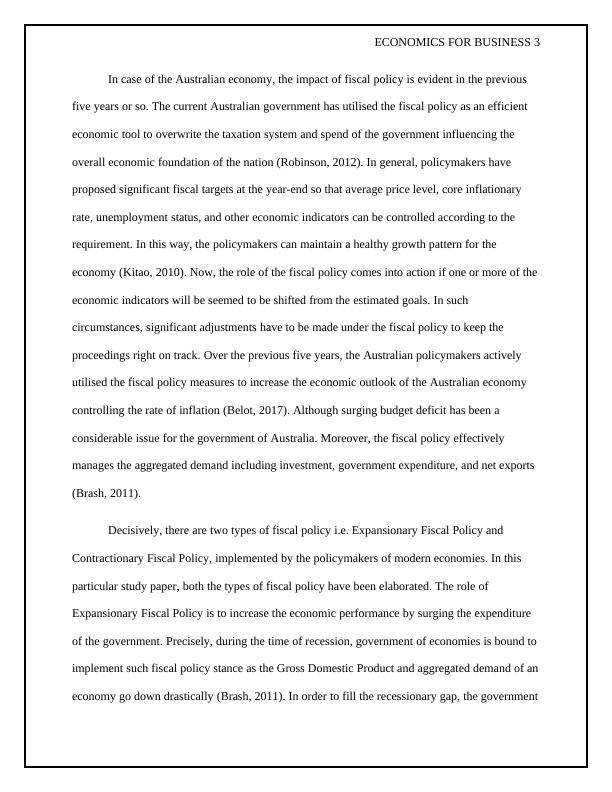HI5003 - Economics | Fiscal Policy of Australian Government in last Five years
Added on 2019-10-30
16 Pages3811 Words159 Views
ECONOMICS FOR BUSINESS 1Fiscal Policy of Australian Government in last Five yearsStudent’s NameCourse IDUniversityDate

ECONOMICS FOR BUSINESS 2In both the developed as well as developing economies, governments in the respective countries have preferred the macroeconomic policies so that financial growth structure and balance of the economic framework will be kept intact. Precisely, fiscal policy and monetary policy can be identified as the two fundamental policy measures taken into account by the governments and central banks to fulfil the economic targets (Brittle, 2010). In this particular study essay, the Fiscal Policy of Australian government in the previous five years has been thoroughly discussed providing a number of argument and evidence. Fiscal Policy stance of any government has been subjected to enhance the economic performance of country by making a number of alterations in taxation and government expenditures (Colander, 2017). John Keynes, aBritish economist, is considered to be the introducer of the concept of fiscal policy. According toKeynes, the government of developed and emerging economies can identify the fiscal policy measures to check the rate of inflation and unemployment status fuelling economic sustainabilityand growth in the long-run (Gärtner, 2016).In this study, the effect of the fiscal policy implemented by the Australian government has also been analysed to find out the policy measures have contributed towards the macroeconomic reforms such as demand and supply in the Australian market. In order to identifythe effect of the fiscal policy of Australian government, the budget deficit for the 2016-17 financial years is projected to be $38.3 billion whereas the Gross Domestic Product is recorded atUS$1204.62 billion in 2016 (Hutchens, 2017). In the meanwhile, the budget deficit of Turnbull government is equal to 2.4 percent of the total GDP in 2016. Precisely, the increasing pressure offiscal deficit has created significant challenges for the Australian government. Relatively, the GDP growth rate, inflation rate, and unemployment status of the economy have been majorly boosted by the fiscal policy of Australian government (Daley and Wood, 2016).

ECONOMICS FOR BUSINESS 3In case of the Australian economy, the impact of fiscal policy is evident in the previous five years or so. The current Australian government has utilised the fiscal policy as an efficient economic tool to overwrite the taxation system and spend of the government influencing the overall economic foundation of the nation (Robinson, 2012). In general, policymakers have proposed significant fiscal targets at the year-end so that average price level, core inflationary rate, unemployment status, and other economic indicators can be controlled according to the requirement. In this way, the policymakers can maintain a healthy growth pattern for the economy (Kitao, 2010). Now, the role of the fiscal policy comes into action if one or more of theeconomic indicators will be seemed to be shifted from the estimated goals. In such circumstances, significant adjustments have to be made under the fiscal policy to keep the proceedings right on track. Over the previous five years, the Australian policymakers actively utilised the fiscal policy measures to increase the economic outlook of the Australian economy controlling the rate of inflation (Belot, 2017). Although surging budget deficit has been a considerable issue for the government of Australia. Moreover, the fiscal policy effectively manages the aggregated demand including investment, government expenditure, and net exports (Brash, 2011).Decisively, there are two types of fiscal policy i.e. Expansionary Fiscal Policy and Contractionary Fiscal Policy, implemented by the policymakers of modern economies. In this particular study paper, both the types of fiscal policy have been elaborated. The role of Expansionary Fiscal Policy is to increase the economic performance by surging the expenditure of the government. Precisely, during the time of recession, government of economies is bound to implement such fiscal policy stance as the Gross Domestic Product and aggregated demand of aneconomy go down drastically (Brash, 2011). In order to fill the recessionary gap, the government

ECONOMICS FOR BUSINESS 4has to increase the spending and cut down the rate of taxation so that a positive impact will be created on aggregated demand curve. In another type of fiscal policy, the government has to implement Contractionary Fiscal Policy to control unmanageable economic growth leading towards high rate of core inflation and asset prices (Ahrend, Catte and Price, 2016). In such situation, to control the rapid growth of the economy, government has to reduce the expenditure to limit the upward aggregated demand curve. Thus, average price level of the economy will be controlled. Basically, fast-growing economies have cut down the job opportunities fuelling unemployment rate to surge. To tackle the scenario, Contractionary Fiscal Policy has become evident to take control of the situation (Hutchens, 2017). Over the previous five years, the Australian government has been targeting to implement strict and tight fiscal policy measures to modify a number of economic indicators according to the fiscal targets (Gilman, 2016). The aim of the federal government of Australia has been pointed at low inflation target, debt reduction, manageable unemployment status, and international trade enhancement (Roettger, 2014). Over the few years, the government has successfully managed to put a break on the increasing standards of aggregated demand determining the government spending level. Under the fiscal policy measures, low government expenditure has been featured so that average price level of commodities can be controlled. Thus, the policymakers and government have determined to keep the inflation rate below 3 percent since 2012. However, Australian government’s debt to GDP has been increasing since 2012 as shown below:

End of preview
Want to access all the pages? Upload your documents or become a member.
Related Documents
Analysis of Macroeconomics in Shanghailg...
|13
|2871
|51
Economic Growth and GDP of Australia over the Last Five Yearslg...
|16
|3446
|258
Macroeconomic Analyses of South Africalg...
|9
|2715
|85
Role of Fiscal Policy in Stabilizing the Australian Economylg...
|20
|3091
|45
Macroeconomics of Malaysia : Reportlg...
|10
|3020
|53
Macroeconomic Environment of Australialg...
|15
|3489
|45
